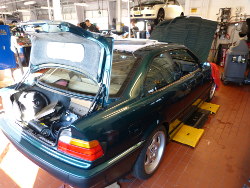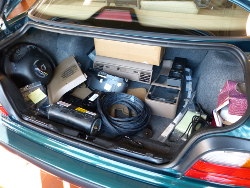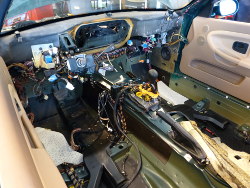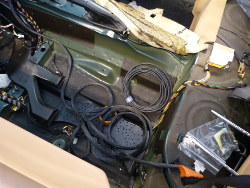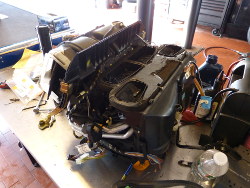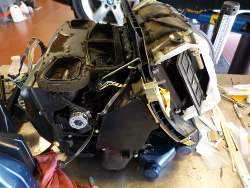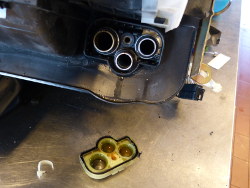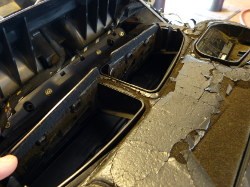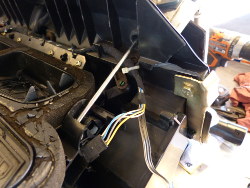Thursday, October 29, 2015
HVAC and Interior Overhaul In Progress
Over the last several months I've been discussing my plans for the HVAC and interior overhaul work with my technician. Between trips back to the body shop and my absolutely insane schedule these days it took a good six months to come up with the plan and acquire the needed parts. My plans finally came together as I delivered the vehicle this week.
Inside the car I managed to cram the carpet and a couple boxes of parts worth about $3K. I also wrote up a list of those parts and a bullet list of the work I wanted done (mostly obvious, but I'm a freak for effective communications and organization). As I left the vehicle in my technician's capable hands I asked him to contact me when the carpet was removed so I could come in and route the custom cable bundles. After texting me a few pictures of his progress the last few days that call came late yesterday afternoon and I arranged with him to arrive this morning.
Routing Cables
I first decided to take some pics and videos for your viewing pleasure, and then set about to examine the best approach to route the cables. My technician and I discussed the nature of the cables first. You are probably familiar with the bundle of individually shielded cables, as I've shown that in prior blog entries. What I added at the last minute, that you have not seen, is a smaller bundle of 2 CAT5 UTP cables commonly used for Ethernet. I can't talk much about those except to say that I have long term plans to develop a suite of audio products that will use them and that they will replace the individually shielded pairs if that product line ever sees the light of day.
In any case, my technician's concern was whether the cables were shielded, and rightfully so -- whenever routing cables near or in parallel to the body harness it's important to avoid interference. I described the larger bundle as individually shielded pairs that were not likely to cause any problem, but the Ethernet cable on the other hand, being unshielded and host to high frequency signals, could cause interference so I said the plan was to route that bundle separately to the extent possible. He then said it probably wouldn't matter as much with this car as its body harness and systems aren't nearly as complicated and potentially sensitive to interference as the current vehicles, but his concern was justified in my opinion. Imagine hacking a modern car with electric steering and turning on the stereo only to get a "bump" in the assist motor. All the more reason to avoid electric assist steering of course but I'm not going to win that argument unless I start my own car company so I won't bitch anymore about it. Probably.
This was around the time when my technician offered to route the cables for me -- an option I hadn't previously considered, but quickly accepted. I think it came down to the reality that it would not have been a 10 minute job, and I would have been forced to move all the parts he stored in the trunk, etc. and generally disturb his workflow. And as anyone who has had a car apart in 100 pieces knows, the last thing you need is someone moving something you put in a particular place so you'd know where to find it when the time came.
Airbox Diagnosis and Repair
We then walked over to the airbox he had on a bench. His first comment was he found the airbox packed full of leaves...which somewhat surprised me given that I'm not stupid enough to run without a microfilter, I tend to replace the filter at the recommended interval, and I always fire up the fan to blow as much of the crud through the open hole in the airbox before I install the new filter. Naturally, he cleaned out the entire airbox and installed a new microfilter.
The second issue we discussed was the airbox door noise that started this whole train running. I earlier described the problem to my technician as a kind of "popping" noise that would typically occur a few minutes after a cold engine start. like when heading out on my morning commute. The time it would take for this popping to occur was inversely related to outside temperature. On particularly cold days it wouldn't happen until 10+ minutes into the drive but on warmer days it would happen before leaving the driveway. So I told him I assumed it had to do with the coolant reaching a particular temperature and the airbox changing the airflow configuration.
I also proposed, purely by instinct, that this was caused by the disintegration of a foam tape or lining on an airbox door, which had left behind a film of adhesive that would lightly bind the door to the airbox when the door closed. When the servo opened the door the next day, the door would break free suddenly, causing the popping sound. Sure enough, that was the cause. My technician showed me that the two large doors on the top center of the airbox (that move in unison and are accessible only through the interior with the dashboard removed, incidentally) were binding with the mating surface in the airbox. He cleaned the remaining foam and adhesive from the doors and then applied a thin felt tape to the doors. Demonstrating the result of his efforts he lifted the doors easily enough and then released them, at which point they closed with a nice, quiet "thunk".
I asked him where he got the felt and he said it was from a kit provided by BMW to silence squeaks and rattles that consists of an assortment of different products. So while I don't have a specific part number or source for anyone else considering this repair, it's fair to say 3M probably makes something that will work. Note, however: some thin 3M foam used primarily for automotive applications like window seals has an adhesive-like property that would not be desirable in this application. I'm not talking here about the adhesive on the back of the foam but rather the foam itself. For that reason I suggest you focus on felt tapes, as that is what my technician used and I have seen first hand works well.
Unfortunately, my technician found one of the arms used to help the servo open the recirculation doors broken. He was able to repair the arm (without accidentally gluing the entire assembly together) but I am not convinced it will last. And I'm not slighting my technician here -- this is more of an observation based on many years spent trying to repair plastic parts like this. Even if repaired well the strength of a fractured plastic component is severely compromised, and cyano isn't the most resilient glue I've seen. I fully expect this to fail again at some point but I doubt I will ever know, just as I had no clue it had broken already.
The real solution would be to install a new arm but (surprise, surprise) BMW does not sell that part separately. A new airbox would obviously solve this problem as well (at least for the first 10 years or so until the foam failed again) but that's clearly a shotgun approach. I also don't know whether they are even available anymore; last I checked they were in BMW parts purgatory -- not ENDED but, with a lead time of 6+ months, just as effectively so I suppose.
To Be Continued
As usual my technician was busy doing a hundred other things so I let him to get back to them. Unless something interesting comes up the next time I see the car it should be at delivery, probably sometime next week. I have made a point of telling my technician all along that he didn't need to rush this and could work on it as his crazy schedule permitted. He asked me again the other day "what's your timeframe?" I responded with something along the lines of "no rush, but the sooner it leaves here the better". Smiling he said "yea, my feeling as well". I did not take it personally. :)
Video: BMW E36 Restoration Update: HVAC and CarpetMileage: 261500




